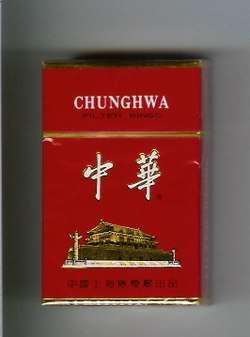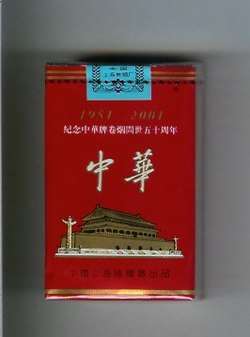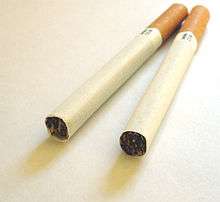Chunghwa (cigarette)
Chunghwa (simplified Chinese: 中华; traditional Chinese: 中華; pinyin: Zhōnghuá) is a premium brand of Chinese cigarettes produced by the Shanghai Tobacco Group, a subsidiary of China Tobacco.[1][2] Due to its popularity in the Chinese market, it is considered the most representative brand of Chinese cigarettes and is known as the "national smoke". The cigarette package design is a bright red color with the Tiananmen and its Huabiao pillars in gold on the front.[3] "Chunghwa", or Zhonghua (中华/中華), is one of the common names for China. As a result, advertisements usually use the name as a pun, though this practice has been controversial. For example, the slogan "Love Our Chunghwa" could also translate as "Love Our China"[2] and could therefore be used as advertisement.
 An old Chinese pack of Chunghwa | |
| Product type | Cigarette |
|---|---|
| Produced by | Shanghai Tobacco Group |
| Country | People's Republic of China |
| Introduced | 1949 |
| Markets | See Markets |
The cigarettes have a smell of plums and are purported to have been the preferred cigarette brand of Mao Zedong.[3] The Chunghwa brand can be considered a status symbol, and the cigarettes are often given as gifts.
History
In May 1949, shortly after the establishment of the Shanghai Municipal People's Government of Shanghai, the Military Control Commission took over the former Chinese national government tobacco company and set up a state-owned Chinese Tobacco Company.
The company solicited in the "Liberation Daily" newspaper suggestions for the official package logo. After the advertisement was published, many people submitted proposals. The accepted design was of the Tiananmen Gate with a dark red background and a gold five-pointed star, the Tiananmen Gate on both sides with two large Chinese tables, painted below the Golden Water Bridge, in the upper middle printed with "Chunghwa cigarettes," the back of the packaging painted with a base Dahua table in the middle printed with "Chunghwa cigarettes."[4]
On February 13, 1951, the Chinese tobacco company in the "Tobacco Daily" published their first advertisement for their brand.
After 1952, the Chinese Tobacco Company was incorporated into the Shanghai Tobacco Company. By March 1953, Chunghwa had a total production of 16,000 boxes.[5]

Limited supply period
Due to the small number of raw materials, Chunghwa production was low during the Cultural Revolution, and its production was lower than the yield of the 1950s.
Open supply
In 1984, the Shanghai Tobacco Monopoly Bureau and the Shanghai Tobacco Company were established for the implementation of unified management and marketing of the tobacco industry in Shanghai. From 1984 to 1992, Chunghwa sold more than 160,000 cigarettes boxes.
In 1997, Chunghwa had an annual output of 10 million boxes.[6] In 2011 there were sales of more than 900,000 cases.[7] Chunghwa high-end market share in China is more than 50% year-round, and cigarette sales in China for many years have elected Chunghwa as the best brand.[8][9]
Controversy
"I Love China" slogan
The "People's Republic of China Advertising Law" and "Tobacco advertising Interim Measures" on tobacco advertising has been strictly limited, so Shanghai Tobacco Group has been using the slogan "I love China" on large outdoor advertising, set to Tiananmen Square as the background. These ads have the words "Love China" and "Shanghai Tobacco Group" for the inscription. Although Shanghai tobacco Group states that this is a public service ad to promote patriotism and not their products, their intentions continue to be questioned.[10][11] According to a survey, more than half of the people screened said "Chunghwa" [China] should be the name used for publicity of cigarettes.[12] In Shanghai, more than 95% of the sale of tobacco products at shopping malls, supermarkets, convenience stores have "Love China" on the box.[13]
"China" trademark case
According to the 1993 enactment of the "Trademark Law", with the same or similar name of the country, or the name of the name of the seat of the central government agencies a specific location or landmark, graphical same text and graphics, are not allowed to appear on the label. Chunghwa due to the "Chinese" character and pattern Tiananmen Square, Chinese table, a lawyer pursuant to the courts, and to think that these signs on cigarette use damage the country's image, called for the repeal Shanghai Tobacco Group's "China" trademark.[14] The Beijing First Intermediate People's Court held that "China" trademark in 1952 that the application for registration, and formally registered in 1979, released in early 1982, China's first "Trademark Law", according to the law is not retroactive, the Shanghai tobacco Group's "China" can continue to use the trademark.[15]
Markets
Chunghwa is mainly sold in China, but also was or still is sold in Hong Kong, Singapore, Georgia and the United Kingdom.[16][17][18]
Additionally, Chunghwa cigarettes are available in many airport duty-free shops around the world.
See also
References
- Graham Earnshaw (30 December 2005). China Business Guide 2006. China Economic Review Publishing. pp. 378–. ISBN 978-988-98254-5-4.
- Robert N. Proctor (29 January 2012). Golden Holocaust: Origins of the Cigarette Catastrophe and the Case for Abolition. University of California Press. pp. 109–. ISBN 978-0-520-95043-6.
- Restall, Hugo. "All the Tobacco in China". The Wall Street Journal. Retrieved 14 December 2013.
- "中华香烟简介_滚动新闻_新浪财经_新浪网". 新浪网. Retrieved 2012-09-08.
- "第三节 产品选介". 上海市地方志办公室. Retrieved 2012-09-06.
- "中华". 中国烟草市场. Archived from the original on 2011-09-15. Retrieved 2012-09-08.
- "中华":"百万千亿"再出征". 中国烟草. Archived from the original on 2012-12-12. Retrieved 2012-09-08.
- "2008年商业销售额十大卷烟品牌的市场分析". 烟草在线. Archived from the original on 2014-12-05. Retrieved 2012-09-08.
- "2011年1至10月烟草重点品牌分析". 烟悦网. Archived from the original on 2012-01-18. Retrieved 2012-09-08.
- "上海人大代表质疑:"爱我中华"怎能成变相烟草广告". 新华网. Retrieved 2012-09-05.
- "烟草广告横行海南 政府如何加大监管力度?(图)". 海南在线. Archived from the original on 2009-06-18. Retrieved 2012-09-05.
- "六成网民认为"爱我中华"不适合为烟草广告语". 人民网. Archived from the original on 2012-10-31. Retrieved 2012-09-05.
- ""爱我中华"烟草广告遭批 市民称损国家形象". 腾讯新闻. Retrieved 2012-09-05.
- "律师告商评委要求除名中华烟 诉其影响国家形象". 人民网. Retrieved 2012-09-05.
- "律师起诉要求撤销"中华"香烟商标被驳回". 新华网. Retrieved 2012-09-05.
- "BrandChunghwa - Cigarettes Pedia". Cigarettespedia.com. Retrieved 9 January 2018.
- "Chunghwa". Zigsam.at. Retrieved 9 January 2018.
- "Brands". Cigarety.by. Retrieved 9 January 2018.
